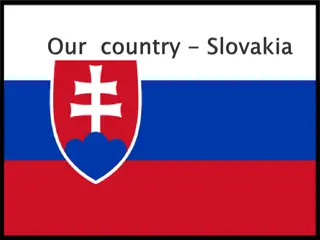
Smart Traffic Evaluation and Influence Modules Based on AI Rules
Enhance traffic systems with non-declarative AI rules for efficient evaluation and influence. Explore the development of smart traffic technologies, project evolution, and economic viewpoints. Dive into I40 value propositions and the integration of Industry 4.0 concepts in the TRAFO project.
Download Presentation

Please find below an Image/Link to download the presentation.
The content on the website is provided AS IS for your information and personal use only. It may not be sold, licensed, or shared on other websites without obtaining consent from the author. If you encounter any issues during the download, it is possible that the publisher has removed the file from their server.
You are allowed to download the files provided on this website for personal or commercial use, subject to the condition that they are used lawfully. All files are the property of their respective owners.
The content on the website is provided AS IS for your information and personal use only. It may not be sold, licensed, or shared on other websites without obtaining consent from the author.
E N D
Presentation Transcript
Development of smart traffic evaluation- and influence-modules based on non-declarative rules of artificial intelligence L SZL PITLIK L SZL PITLIK (JUN) MARCELL PITLIK M TY S PITLIK - RON GYIMESI My-X research team Hungary
Multidisciplinar paper Evolution of a project Power of mathematics Effect of I40 thinking TRAFO (Traffic Optimization System) project - GINOP-2.1.1-15-2016 Traffic simulator based on mathematical forecast of upcoming events based on AI application The goal of the project is a simulator accomplished that can be applied universally
An economists view Key findings by the tender documentation: Bottom up approach technology oriented project The core modeling technology was not decided There was no strategic management frame The value add was not exposed The project seemed a quasi I40 project
Proof of Concept Hypothesis: We assumed that our previously published function consisting the I40 value proposition and I40 management framework can be applied to TRAFO project Expected result: the PoC TRAFO is an I40 project, I40 management framework is operational in this case
Value oriented I40 definition Industry 4.0 is the integration of complex physical machinery and devices with networked sensors and software, used to predict, control and plan for better business and societal outcomes. (LU, 2017)
I40 value proposition I40 project value proposition = utilizing the new technologies + generating information + using autonomous decision making procedures + applying I40 management framework (targeted busines layer + deficit management + strategic management tools) (Gyimesi, 2017)
TRAFO was not designed as an I40 project Missing technology decisions Missing I40 management framework elements: Business Layer Goal (Technology, Internal Process Cost Effectiveness, Business-Sales Layer) Deficit management and risk mitigation (Internal, Contractual, Governmental) I40 strategic management framework (I40 related strategic decisions to make project happen)
TRAFO retroactively become I40 compliant along with the project meetings we provided the missing the theoretical and also operational elements Technologies: (Android, MongoDB, Cloud-based AI-server with API) Goals: Business-Sales Layer Deficit management: along with the project management (Key deficits: knowledge, interfacing, missing econometrics, missing premade modules, lack of standards) Management framework: along with the project management (Comparisons, Add values, Inclusivity / Exclusivity, Income models, Meaning of general solution, Usable legacy systems, IT security)
Confirmed: Function applicable TRAFO (retroactive) I40 value proposition = Android, MongoDB, Cloud-based AI-server with API + traffic related data defined controller information + AI decisions for better traffic evaluation + applied I40 management framework (new business + risk minimization as deficit management + core decisions by the I40 strategic management tool) PoC: The function and the I40 management framework provide real guideline and accelerator. These helped focusing, also making simple and add value to the project.
AI Modeling State of the art approach Solution without classic physics based behaviour patterns of moving objects The core idea is based on abstraction of similarities - idea of the universal model Similarities make possible to derive non-declarative rules Similarities ensure multi-layered evaluation in an automated way Findings The aggregated evaluation can be derived for the entire traffic system and/or also for its parts Time series of the evaluation derives parallel models being able to estimate the next aggregated evaluation value of traffic
The basic pillars of the project are from KNUTH (1992: Science is what we understand well enough to explain to a computer. Art is everything else we do.) Thank you for your attention!
Details PPT: http://miau.gau.hu/miau/239/kosice.pptx Full text: http://miau.gau.hu/miau/238/Manuscript_Template _2017_myx.docx Studies: Pitlik L. et al. (2018a). Traffic-optimization: monitoring/evaluation sub-system, MIAU No.233 HU ISSN 14191652, http://miau.gau.hu/miau/233/kvant_monitoring_v5.docx Pitlik L. et al. (2018b). Simulation layers of traffic management based on similarity analyses, MIAU No.235 HU ISSN 14191652, http://miau.gau.hu/miau/235/kvant_simulation_v1.docx Pitlik L. et al. (2018c). Genetic potential in the traffic optimization, MIAU No.235 HU ISSN 14191652, http://miau.gau.hu/miau/235/kvant_geneticpotential_v1.docx Gyimesi ron (2018): Az Ipar 4.0 paradigma adapt ci j nak lehet s gei s korl tai a v llalatok szemsz g b l, Tavaszi Sz l Konferencia, Sz chenyi Istv n Egyetem 2018.05.04.
Contact information Ph.D. L szl Pitlik; University of G d ll , Faculty of Economics and Social Sciences, MY-X research team, P ter K. u. 1. H-2013, G d ll , Hungary, pitlik@miau.gau.hu L szl Pitlik; E tv s Lor nd University, Faculty of Sciences, P zm ny P. stny. 1/A H- 1117, Budapest, Hungary; ELTE Illy s S ndor College for Advanced Studies, N ndorfej rv ri u. 13. H-1117, Budapest, Hungary, ptlklszl@caesar.elte.hu Marcell Pitlik; Budapest University of Technology and Economics, Faculty of Mechanical Engineering, M egyetem rkp. 3. H-1111, Budapest, Hungary, pitlikmarci@gmail.com M ty s Pitlik; E tv s Lor nd University, Faculty of Informatics, P zm ny P. stny. 1/C H-1117, Budapest, Hungary, pitlikm@inf.elte.hu ron Gyimesi; Sz chenyi Istv n University, Doctoral School of Economics and Regional Sciences, Egyetem t r 1. H-9026 Gy r, Hungary, gyimesi.aron@yahoo.com



